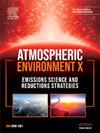Investigating the effects of animal-specific δ15N-NH3 values volatilized from livestock waste on regional NH3 source partitioning
IF 3.4
Q2 ENVIRONMENTAL SCIENCES
引用次数: 0
Abstract
The natural 15N abundance of ammonia (δ15N-NH3) emitted from livestock waste within a specific area (δ15N-NH3-LW) can be used to estimate its contribution to atmospheric NH3 through an isotope mixing model. However, the limited availability of reports on δ15N-NH3-LW hinders the accuracy of regional NH3 source partitioning. In this study, we conducted research in the suburbs of Shenyang, China, and combined our results (n = 71) with data from published literature (n = 56) to develop a δ15N-NH3 spectrum emitted from cattle, pig, sheep, and poultry waste. We also explored the national and global spatial distribution of δ15N-NH3-LW based on the proportion of NH3 emissions from these four types of livestock waste. Our results showed that the δ15N-NH3 values ranged from −59.9‰ to −7.7‰, with a mean value of −27.3‰. This value was significantly lower than that from non-agricultural sources, such as coal combustion and motor vehicle exhaust, but overlapped with values from fertilizer N volatilization. Specifically, the δ15N-NH3 values emitted from cattle, pig, sheep, and poultry waste were −32.1 ± 15.9‰, −20.7 ± 7‰, −24.3 ± 5.9‰, and −19.1 ± 4.9‰, respectively. Considering regional differences in livestock farming structures, δ15N-NH3-LW exhibited a gradual decreasing trend from Southeast to Northwest across China. For example, Fujian Province, located on the southeastern coast, exhibited the highest δ15N-NH3-LW value of −19.8‰, owing to its high proportion of poultry farming, while the Tibet Autonomous Region, in the western inland, displayed the lowest δ15N-NH3-LW value of −30.8‰, due to its high proportion of cattle farming. Globally, the δ15N-NH3-LW value was highest in Southeast Asia (−23.4‰) and lowest in East Africa (−30.4‰). Overall, our study revealed significant spatial variation in δ15N-NH3-LW at both national and global scales. To more accurately assess the regional contributions of NH3 emissions from livestock waste, it is essential to use region-specific δ15N-NH3-LW values for future NH3 source partitioning.
研究畜禽粪便挥发的动物特异性δ15N-NH3值对区域NH3源分配的影响
在特定区域(δ15N-NH3- lw)内,畜禽粪便排放的氨(δ15N-NH3)的自然15N丰度可以通过同位素混合模型来估计其对大气NH3的贡献。然而,δ15N-NH3-LW报告的有限可用性阻碍了区域NH3源划分的准确性。在这项研究中,我们在中国沈阳郊区进行了研究,并将我们的结果(n = 71)与已发表文献(n = 56)的数据相结合,建立了牛、猪、羊和家禽粪便排放的δ15N-NH3光谱。基于这四种畜禽废弃物NH3排放比例,探讨了δ15N-NH3-LW的国家和全球空间分布。结果表明:δ15N-NH3值在−59.9‰~−7.7‰之间,平均值为−27.3‰;该值明显低于燃煤和机动车尾气等非农业来源的值,但与肥料N挥发的值重叠。其中,牛、猪、羊、禽粪便排放的δ15N-NH3值分别为- 32.1±15.9‰、- 20.7±7‰、- 24.3±5.9‰和- 19.1±4.9‰。考虑到畜牧业结构的区域差异,δ15N-NH3-LW在中国呈现由东南向西北逐渐减小的趋势。例如,位于东南沿海的福建省由于家禽养殖比例高,δ15N-NH3-LW值最高,为- 19.8‰,而位于西部内陆的西藏自治区由于养牛比例高,δ15N-NH3-LW值最低,为- 30.8‰。全球δ15N-NH3-LW值东南亚最高(- 23.4‰),东非最低(- 30.4‰)。总体而言,我们的研究揭示了δ15N-NH3-LW在国家和全球尺度上的显著空间差异。为了更准确地评估畜禽粪便NH3排放的区域贡献,有必要使用区域特定的δ15N-NH3-LW值来划分未来的NH3源。
本文章由计算机程序翻译,如有差异,请以英文原文为准。
求助全文
约1分钟内获得全文
求助全文
来源期刊

Atmospheric Environment: X
Environmental Science-Environmental Science (all)
CiteScore
8.00
自引率
0.00%
发文量
47
审稿时长
12 weeks
 求助内容:
求助内容: 应助结果提醒方式:
应助结果提醒方式:


